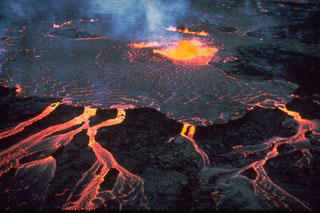Report on Kilauea (United States) — 1 August-7 August 2018
Smithsonian Institution / US Geological Survey
Weekly Volcanic Activity Report, 1 August-7 August 2018
Managing Editor: Sally Sennert.
Please cite this report as:
Global Volcanism Program, 2018. Report on Kilauea (United States) (Sennert, S, ed.). Weekly Volcanic Activity Report, 1 August-7 August 2018. Smithsonian Institution and US Geological Survey.
Kilauea
United States
19.421°N, 155.287°W; summit elev. 1222 m
All times are local (unless otherwise noted)
HVO reported that the eruption at Kilauea’s Lower East Rift Zone (LERZ) and within Halema`uma`u Crater continued during 1-2 August, with lava flowing through the channel and into the ocean producing laze at several points along a broad 2-km-wide flow front at Ahalanui. A few spillovers from the channel set vegetation on fire. By 3 August the lava-flow velocity in the channel was low and on 4 August the output at Fissure 8 had waned. Part of the flow field shifted W about 250 m; the westernmost edge was about 70 m NE of the boat ramp in Isaac Hale Park by 5 August. The lava channel was completely crusted over by 6 August, and a lava lake bubbled in the Fissure 8 cone. The laze plumes at the ocean entry were greatly diminished. During 7-8 August the lava lake in Fissure 8 was 5-10 m below the spillway into the channel. A decreasing number of small active ooze outs near the coast were visible.
A collapse event at the summit was recorded at 1155 on 2 August. Seismicity increased afterwards as has been typical since early on in the LERZ eruption, but then decreased along with the rate of deformation. By 7 August deformation had almost stopped. The quiet conditions at the summit represented a significant change from the pattern of seismicity and deformation detected over the past several months.
Geological Summary. Kilauea overlaps the E flank of the massive Mauna Loa shield volcano in the island of Hawaii. Eruptions are prominent in Polynesian legends; written documentation since 1820 records frequent summit and flank lava flow eruptions interspersed with periods of long-term lava lake activity at Halemaumau crater in the summit caldera until 1924. The 3 x 5 km caldera was formed in several stages about 1,500 years ago and during the 18th century; eruptions have also originated from the lengthy East and Southwest rift zones, which extend to the ocean in both directions. About 90% of the surface of the basaltic shield volcano is formed of lava flows less than about 1,100 years old; 70% of the surface is younger than 600 years. The long-term eruption from the East rift zone between 1983 and 2018 produced lava flows covering more than 100 km2, destroyed hundreds of houses, and added new coastline.
Source: US Geological Survey Hawaiian Volcano Observatory (HVO)

